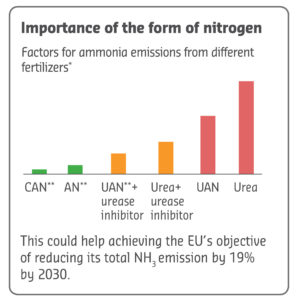European farms are essential in providing quality food that can sustain life on this planet today and in the future. However, agricultural activities also impact environment. For example, agriculture is responsible for 92% of ammonia emissions that impact air quality in Europe and 17% of these emissions derive from the use of nitrogen fertilizers.
Ammonia emissions have both impacts on human health (contribution to the formation of particulate matter in the atmosphere) and on environment (acid deposition and eutrophication). It is since the late 1970s that cleaner air has been one of the key environmental policy priorities in Europe. The European Commission has recently published the “First Clean Air Outlook” which identifies the efforts needed in the run up to 2030 to solve i.e. the challenge of ammonia emissions from agriculture.
The farming sector experiences mounting pressure to deliver on these environmental challenges. The fertilizer industry strives to support farmers to address these challenges by providing them with better products and know-how that can support them in improving air quality while remaining economically viable.
Solutions are already available. Good fertilization practices can help farmers make optimal decisions to improve resource efficiency and consequently reduce ammonia emissions.
Good practices for optimal use of mineral fertilizers
There are already several, well-known good agricultural practices, which European farmers can implement to minimize ammonia losses.
- Choice of fertilizer type
The form of nitrogen used is very important. Calcium ammonium nitrate and ammonium ensure the lowest emissions. Thus, it is crucial not to look only at the price of mineral fertilizers, but also at their agronomic and environmental characteristics.

- In case of Urea use
Depending on the site-specific farm conditions, urea might remain a viable option. In this case it is important to follow a series of good practices.
- Immediate incorporation.
Incorporation of urea into the soil immediately upon spreading, either by closed-slot injection or by cultivation, reduces potential volatilization losses by up to 70%. However, also in this case, ammonia emissions still remain more than 3 times higher than those from CAN/AN.
- Consider weather conditions.
Spreading urea under hot and windy conditions with no rainfall expected upon spreading should be avoided. On the contrary, humid soils improve diffusion, while cool weather conditions (< 15 °C) curb the formation of ammonia in the soil and subsequent volatilization losses from urea.
- Consider soil conditions.
Soils with a high pH result in higher volatilization losses. Urea and UAN therefore shall not be spread on such soils.
- Split application
Spreading mineral fertilizers in two or three applications during the crop cycle instead of one time at the beginning of the growing season allows to better match the plant needs and therefore reduces potential losses caused by higher ammonia concentrations and volatilizations risks.
- Inhibitors
For site-specific farm conditions, urea containing inhibitors might remain a good option. An inhibitor is an agronomic additive added to a nitrogen-based fertilizer to reduce losses when the fertilizer has been applied to the crop. Urea inhibitors can improve nitrogen use efficiency and reduce environmental impacts of urea. By extending the time the active nitrogen component of the fertilizer remains in the soil, an inhibitor reduces ammonia losses in average by -70 to 80% (UNECE estimates based on S. Bittman et al., 2013).
- Precision fertilization for cleaner air
Precision farming contributes to enhanced uptake of nitrogen by the plants and thus reduced losses of ammonia to the air. According to the agricultural outlook of the European Commission (December 2017) ammonia emissions linked to agriculture in Europe are expected to decline by 10% until 2030 (base year 2008) thanks to the growing development and use of new technologies. The European fertilizer industry has been working actively in the development of new tools to facilitate the fertilization decision of farmers such as planning instruments, soil analysis, decision-support instruments (testers or apps), variable rate application via GPS or sensors. The advantage of those techniques and tools is that they work both for the environment and the economics of the farm. Combined with precision nutrition, the application of nitrate-based fertilizers, such as ammonium nitrate, CAN or NPKs, makes it even more efficient.
The current revision of the Common Agriculture Policy (CAP) is a unique opportunity to raise awareness about products and practices to reduce ammonia emissions. As part of the new CAP, a new tool has been proposed that will support farmers in the use nutrients, helping them to reach better yields.
Article published in Fertilizer Focus Magazine.